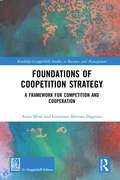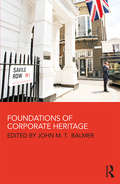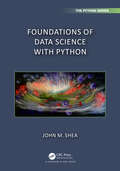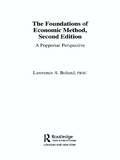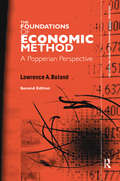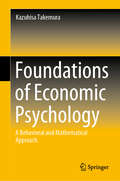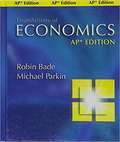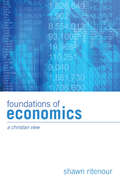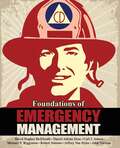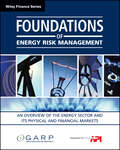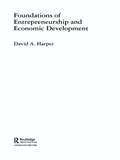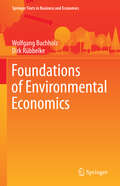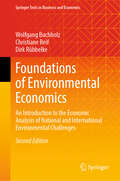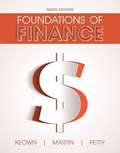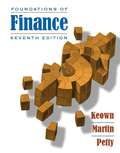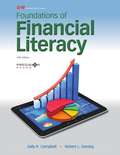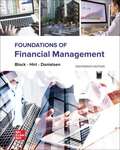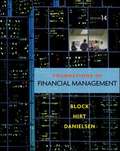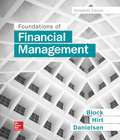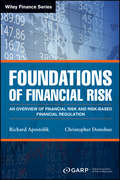- Table View
- List View
Foundations of Coopetition Strategy: A Framework for Competition and Cooperation (Routledge-Giappichelli Studies in Business and Management)
by Giovanni Battista Dagnino Anna MinàThis book disentangles the foundations of coopetition (i.e., concurrent competition and cooperation) by exploring in-depth the intellectual legacy of Eastern and Western perspectives. In particular, it detects the foundations of coopetition in three Chinese streams of thought; Confucianism, Taoism, and Legalism, and in five Western schools of thought; David Hume, Adam Smith, Immanuel Kant, Georg Wilhelm Frederich Hegel and Søren Kierkegaard. In such a way, it unveils four logics used to tackle the essence of coopetition, respectively either/or, both/and, both/or, and either/and. The key objectives of the book are: firstly, to adopt a paradoxical lens to investigate the foundations of coopetition strategy. Secondly, to offer an interpretive framework that detects the different forms, tactics and patterns of coopetition. Thirdly, to discuss the implications of the framework proposed for other paradoxical strategies and to distil a bouquet of managerial implications. In such a way, the volume combines existing foundational perspectives with a contemporary interpretation of the coopetition phenomenon, thereby offering a valuable understanding of the current business and management world. The guiding principles of the book enable readers to extricate the dichotomy between the phenomenon of coopetition and coopetitive strategy, appraise the rationale for distinguishing between deliberate (planned) coopetition strategy and emergent (unplanned, but conscious) coopetition strategy, and understand how to deal with coopetition tensions.
Foundations of Corporate Heritage
by John M. BalmerHeritage is increasingly recognised as a significant corporate concern, with corporate heritage brands and identities often forming an important part of a nation's patrimony. Foundations of Corporate Heritage explains the principles, processes, strategic significance – and challenges – of corporate heritage formation and management. This scholarly but accessible anthology includes seminal articles on the territory and also includes five new contributions with questions for study and reflection with students on executive/taught courses in mind. With contributions from the leading international experts in corporate heritage, this book examines the research foundations of the area and applications in practice. It will be important supplementary reading for students, practitioners and specialists in corporate marketing brand management and marketing communications, as well as tourism, hospitality and heritage studies.
Foundations of Data Science with Python (Chapman & Hall/CRC The Python Series)
by John M. SheaFoundations of Data Science with Python introduces readers to the fundamentals of data science, including data manipulation and visualization, probability, statistics, and dimensionality reduction. This book is targeted toward engineers and scientists, but it should be readily understandable to anyone who knows basic calculus and the essentials of computer programming. It uses a computational-first approach to data science: the reader will learn how to use Python and the associated data-science libraries to visualize, transform, and model data, as well as how to conduct statistical tests using real data sets. Rather than relying on obscure formulas that only apply to very specific statistical tests, this book teaches readers how to perform statistical tests via resampling; this is a simple and general approach to conducting statistical tests using simulations that draw samples from the data being analyzed. The statistical techniques and tools are explained and demonstrated using a diverse collection of data sets to conduct statistical tests related to contemporary topics, from the effects of socioeconomic factors on the spread of the COVID-19 virus to the impact of state laws on firearms mortality.This book can be used as an undergraduate textbook for an Introduction to Data Science course or to provide a more contemporary approach in courses like Engineering Statistics. However, it is also intended to be accessible to practicing engineers and scientists who need to gain foundational knowledge of data science.Key Features: Applies a modern, computational approach to working with data Uses real data sets to conduct statistical tests that address a diverse set of contemporary issues Teaches the fundamentals of some of the most important tools in the Python data-science stack Provides a basic, but rigorous, introduction to Probability and its application to Statistics Offers an accompanying website that provides a unique set of online, interactive tools to help the reader learn the material
Foundations of Deep Metaphors: How Managers Benefit from Discovering Consumer Similarities
by Gerald Zaltman Lindsay ZaltmanThis chapter introduces some of the social, psychological, physical, and neurological bases for the deep metaphors that can help managers better understand the hearts and minds of consumers.
Foundations of Dynamic Economic Analysis
by Michael R. CaputoPresenting a thorough introductory exposition of optimal control theory, this work differs from the existing textbooks on the subject due to its emphasis on the economic interpretation of the mathematics and the qualitative properties of the solutions. Moreover, it is a modern exposition of optimal control theory in that it presents numerous complementary methods. It is aimed at first-year and second-year PhD students in economics, agricultural and resource economics, operations research, management science, and applied mathematics.
Foundations of Economic Method: A Popperian Perspective
by Lawrence Boland Tom WarlowMany consider Foundations of Economic Method to be Lawrence Boland's best work. This updated edition is radically changed from the original and will be much appreciated by thinkers within economics. The book positions methodology vis-is the current practice of economists and is all the better for it. Yet another book that not only deserves to be r
Foundations of Economic Method: A Popperian Perspective, 2nd Edition
by Lawrence A. BolandMany consider Foundations of Economic Method to be Lawrence Boland's best work. This updated edition is radically changed from the original and will be much appreciated by thinkers within economics. The book positions methodology vis-à-vis the current practice of economists and is all the better for it. Yet another book that not only deserves to be read by those within the field of economic methodology, but also by those involved in economics at all. Boland is back.
Foundations of Economic Psychology: A Behavioral and Mathematical Approach
by Kazuhisa TakemuraThis book provides an overview of the concept of economic psychology from behavioral and mathematical perspectives and related theoretical and empirical findings. Economic psychology is defined briefly as a general term for descriptive theories to explain the psychological processes of microeconomic behaviors and macroeconomic phenomena. However, the psychological methodology and knowledge of economic psychology have also been applied widely in such fields as economics, business administration, and engineering, and they are expected to become increasingly useful in the future—a trend suggested in several eminent scholars’ studies.The book explains the numerous behavioral and mathematical models of economic psychology related to micro- and macroeconomic phenomena that have been proposed in the past, and introduces new models that are useful to explain human economic behaviors. It concludes with speculations about the future of modern economic psychology, referring to its connection with fields related to neuroscience, such as neuroeconomics, which have been developed in recent years.Readers require no advanced expertise; nonetheless, an introductory understanding of psychology, business administration, and economics, and a high- school-graduate level of mathematics are useful. To aid readers, each chapter includes a bibliography, which can be referred for more details related to economic psychology.
Foundations of Economics (AP Edition)
by Parkin Bade<p>Everyone agrees that they only way to learn economics is to do it. Rote memorization does not work. The keys to success in economics are active involvement and working problems. To help students succeed, the Bade/Parkin package is designed to encourage learning by doing. After all, practice makes perfect! <p>Practice is the cornerstone of the innovative Bade/Parkin approach. Each chapter of Foundations of Economics concentrates on a manageable number of core concepts. A full page Checkpoint--containing a Practice Problem with solution and a parallel Exercise--immediately follows each main idea. Checkpoints serve as stopping points and encourage students to practice using a concept before moving on. <p>Different learning styles need different learning tools, and eFoundations, Bade/Parkin's extensive web environment, puts students in the driver's seat and allows them to use technology in the way that suits them best.</p>
Foundations of Economics: A Beginner's Companion
by Yanis VaroufakisFoundations of Economics breathes life into the discipline by linking key economic concepts with wider debates and issues. By bringing to light delightful mind-teasers, philosophical questions and intriguing politics in mainstream economics, it promises to enliven an otherwise dry course whilst inspiring students to do well.The book covers all the main economic concepts and addresses in detail three main areas:* consumption and choice* production and markets* government and the State.Each is discussed in terms of what the conventional textbook says, how these ideas developed in historical and philosophical terms and whether or not they make sense. Assumptions about economics as a discipline are challenged, and several pertinent students' anxieties ('Should I be studying economics?') are discussed.
Foundations of Economics: A Christian View
by Shawn RitenourFoundations of Economics: A Christian View is an introduction to economics from an explicitly Christian perspective. It maintains that there is no conflict between Christian doctrine and economic science, properly understood. Therefore, Foundations of Economics has three goals: to demonstrate that the foundations of economic laws are derived from a Christian understanding of nature and humanity; to explain basic economic principles of the market economy and apply them to various economic problems, such as poverty and economic development; and to show the relationship between Christian ethics and economic policy. Foundations of Economics: A Christian View accomplishes these goals by rooting the fundamental principles of human action in the Christian doctrines of creation and humanity, and integrating them with the Christian ethic of private property. This volume explains the relevance of economics for fulfilling the cultural mandate set forth in the first two chapters of Genesis, by demonstrating how economics can help us in our task to be fruitful and multiply and have dominion over the earth, without spoiling creation, starving to death, or descending into a barbaric struggle for survival.
Foundations of Emergency Management
by Carl Jensen David Mcelreath Robert Nations Julie Nations Michael Wigginton Jeffrey M Van Slyke Adrian DossOn a daily basis, the United States, and the entire world in general, face the reality and responsibility of managing hazards, emergencies, and disasters. A disaster may strike at any time with little or no warning. Incidents may also occur with speed, surprise, and violence. Any location is vulnerable to some form of hazard. The 2020 COVID-19 outbreak is just one indication that dangers, often unanticipated, may impact an area, region, nation, or in the case of COVID-19, the global community. Thus, communities throughout the world must acknowledge the importance and relevance of emergency management with respect to an array of diverse threats. Foundations of Emergency Management highlights the importance of effective emergency management and provide a cumulative overview and introduction to the fundamental aspects of emergency management. Emergency management is a discipline of global importance. Foundations of Emergency Management examines the history, hazards, power, role, future, and other aspects of emergency management. To help the reader comprehend concepts covered, the publication includes learning objectives, numerous images / graphics, chapter summaries, key terms, references, and thought and discussion questions.
Foundations of Energy Risk Management
by GARPGARP's Fundamentals of Energy Risk Management introduces investors to the basic components and some of the basic terminology used in the energy industry. It covers the commodity cycle, energy use and sources, and various risk types, various energy products and the markets where energy is traded. It also introduces certain risk management fundamentals and real option thinking. The book is GARP's required text used by risk professionals looking to obtain their Certificate in Energy Risk Management.
Foundations of Entrepreneurship and Economic Development (Routledge Foundations Of The Market Economy Ser.)
by David A HarperThis well-written book is the first to deal with entrepreneurship in all its aspects. It considers the economic, psychological, political, legal and cultural dimensions of entrepreneurship from a market-process perspective. David A Harper has produced a volume that analyses why some people are quicker than others in discovering profit opportunities
Foundations of Environmental Economics (Springer Texts in Business and Economics)
by Wolfgang Buchholz Dirk RübbelkeThis textbook provides a solid introduction to the theoretical and empirical aspects of environmental economics, and their links to environmental policy. It advocates drawing on the economist’s toolbox as a powerful means of finding solutions to environmental problems by addressing the conflict between the societal costs of pollution on the one hand, and the financial costs of emissions reduction on the other. The book presents the main economic theory approaches to handling environmental problems and assessing the monetary value of environmental quality; the most relevant environmental policy instruments and challenges involved in their effective real-world application; and both national and global environmental problems addressed by environmental negotiations and agreements. Given its scope, the book offers a valuable basis of information for students, and for policymakers pursuing effective environmental policies.
Foundations of Environmental Economics: An Introduction to the Economic Analysis of National and International Environmental Challenges (Springer Texts in Business and Economics)
by Wolfgang Buchholz Dirk Rübbelke Christiane ReifThis textbook provides a solid introduction to the theoretical and empirical aspects of environmental economics and their links to environmental policy. In this second edition, all chapters have been updated and restructured, and new sections have been added to reflect a greater focus on climate policy. Starting from the need to balance the social costs of pollution against the financial costs of emission abatement, the book discusses the major issues that arise in the context of environmental policy – such as the potential and limitations of monetary valuation of the environment (and in particular the contingent valuation method) and the design of environmental policy. With regard to the choice of environmental policy instruments, the book focuses on the price-based instruments preferred by economists, i.e., environmental taxes and emissions trading, discussing in detail not only their many advantages but also their drawbacks. The second edition especially focuses on green industrial policy as a complementary measure to price-based instruments, the distributional effects of environmental policies, and the resulting challenges for political feasibility. Moreover, the book deals extensively with international environmental problems, in particular climate protection, which is a global public good that will be underprovided when certain countries refuse to cooperate and contribute. Approaches to overcoming this underprovision are described in far more detail than in the first edition, both theoretically and empirically – in particular by assessing the functions of the many international environmental agreements in this field. Finally, a new chapter considers adaptation strategies, especially in the water sector, as an additional pillar of climate policy.
Foundations of Family Resource Management
by Elizabeth B. GoldsmithFoundations of Family Resource Management uses the lenses of consumer science, management, and economics, and beyond to help students make intelligent decisions about resources, time, and energies at the individual and family level. It has a strong interdisciplinary, global, and multicultural focus. This sixth edition brings in new material on millennials, delayed marriage, household composition, neuroscience, behavioral economics, sustainable consumption, technology, and handling crises. It has been updated in line with the latest census data and academic literature. The text contains lots of features to support student learning, including chapter summaries, "Did You Know?" questions, glossary of key terms, examples and cases, critical thinking activities, and review questions for discussion and reflection. Lecture slides and an instructor manual are available as digital supplements. This textbook meets the standards and criteria for the Certified Family Life Educator (CFLE) designation of the National Council on Family Relations (NCFR) and will be suitable for resource management courses in family and consumer science, human ecology, and human environmental science programs.
Foundations of Family and Consumer Sciences: Careers Serving Individuals, Families, and Communities
by Sharleen Gay KatoFoundations of Family and Consumer Sciences is a college-level textbook designed to introduce students to the family and consumer sciences profession. An overview of the profession, including history and trends is presented. Career opportunities for each family and consumer sciences specialization area are explored and come to life in Professional Profiles and Issues in the News features. The text guides students in how to move into the workplace and how to make a difference in the lives of others.
Foundations of Finance: The Logic and Practice of Financial Management
by John Martin Arthur Keown J. PettyFoundations of Finance retains its foundational approach to the key concepts of finance, bolstered by real-world vignettes, cases, and problem exercises. Utilizing five principles, which are presented at the beginning of the book and applied throughout, the authors introduce a multi-step approach to financial problem solving that appeals to readers’ at all levels, math and numerical skills. As in previous editions, the Ninth Edition focuses on valuation and opens every chapter with a vignette based on financial decisions faced by contemporary, real-world companies and firms. Other highly useful features include mini cases, cautionary tales, lists of key terms, and a discussion of ethics. Revised and updated, the newest edition includes new lecture videos, financial thinking, user feedback, and lessons from the recent economic crisis.
Foundations of Finance: The Logic and Practice of Financial Management (7th Edition)
by John D. Martin Arthur J. Keown John W. Petty J. William PettyFoundations of Finance enables students to see the big picture by letting them understand the logic that drives finance rather than having them memorize formulas. The book motivates the study of finance with a focus on five underlying principles.
Foundations of Financial Management
by Geoffrey A. Hirt Bartley Danielsen Stanley B. BlockFoundations of Financial Management has built a loyal following due to its strong real-world emphasis, clear writing style, and step-by-step explanations that simplify difficult concepts. As the field of finance has become much more analytical, the text focuses on the "nuts and bolts" of finance with a clear and thorough treatment of concepts and applications. The authors emphasize decision-oriented approaches rather than the old, descriptive approach. They have also stayed with their basic mission of making sure students can follow their discussions throughout the text. Block, Hirt, and Danielsen have always been devoted to producing a high-quality text by writing the entire book and all the problems themselves. The authors know what works and what doesn't work for students, and they have consistently maintained a product that is responsive to the demands of the marketplace.
Foundations of Financial Management (Fourteenth Edition)
by Stanley Block Geoffrey Hirt Bartley DanielsenFoundations of Financial Management has built a loyal following due to its strong real-world emphasis, clear writing style, and step-by-step explanations that simplify difficult concepts. The text focuses on the "nuts and bolts" of finance with clear and thorough treatment of concepts and applications. In addition to completing the textbook revisions, Block, Hirt, and Danielsen also revise all end of chapter problems and complete the solutions themselves. The authors know what works and what doesn't work for students, and they have consistently maintained a high quality textbook that is responsive to the demands of the marketplace.
Foundations of Financial Management (Sixteenth Edition)
by Geoffrey A. Hirt Stanley B. Block Bartley R. DanielsenFoundations of Financial Management has built a loyal following due to its strong real-world emphasis, clear writing style, and step-by-step explanations that simplify difficult concepts. The text focuses on the "nuts and bolts" of finance with clear and thorough treatment of concepts and applications. In addition to completing the revisions, Block, Hirt, and Danielsen also revise all end of chapter problems and complete the solutions themselves. The authors know what works and what doesn't work for students, and they have consistently maintained a product that is responsive to the demands of the marketplace.
Foundations of Financial Risk: An Overview of Financial Risk and Risk-based Financial Regulation (Wiley Finance)
by GARP (Global Association of Risk Professionals) Richard Apostolik Christopher DonohueGain a deeper understanding of the issues surrounding financial risk and regulation Foundations of Financial Risk details the various risks, regulations, and supervisory requirements institutions face in today's economic and regulatory environment. Written by the experts at the Global Association of Risk Professionals (GARP), this book represents an update to GARP's original publication, Foundations of Banking Risk. You'll learn the terminology and basic concepts surrounding global financial risk and regulation, and develop an understanding of the methods used to measure and manage market, credit, and operational risk. Coverage includes traded market risk and regulation, treasury risk and regulation, and much more, including brand new coverage of risk management for insurance companies. Clear explanations, focused discussion, and comprehensive relevancy make this book an ideal resource for an introduction to risk management. The textbook provides an understanding of risk management methodologies, governance structures for risk management in financial institutions and the regulatory requirements dictated by the Basel Committee on Banking Supervision. It provides thorough coverage of the issues surrounding financial risk, giving you a solid knowledgebase and a practical, applicable understanding. Understand risk measurement and management Learn how minimum capital requirements are regulated Explore all aspects of financial institution regulation and disclosure Master the terminology of global risk and regulation Financial institutions and supervisors around the world are increasingly recognizing how vital sound risk management practices are to both individual firms and the capital markets system as a whole. Savvy professionals recognize the need for authoritative and comprehensive training, and Foundations of Financial Risk delivers with expert-led education for those new to risk management.
